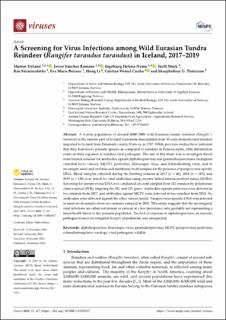A Screening for Virus Infections among Wild Eurasian Tundra Reindeer (Rangifer tarandus tarandus) in Iceland, 2017–2019
Tryland, Morten; Sanchez Romano, Javier; Nymo, Ingebjørg Helena; Mørk, Torill; Þórarinsdóttir, Rán; Breines, Eva Marie; Li, Hong; Cunha, Cristina Wetzel; Thórisson, Skarphéðinn G.
Peer reviewed, Journal article
Published version
Permanent lenke
https://hdl.handle.net/11250/3085423Utgivelsesdato
2023Metadata
Vis full innførselSamlinger
Sammendrag
A winter population of around 4000–5000 wild Eurasian tundra reindeer (Rangifer t. tarandus) in the eastern part of Iceland represents descendants from 35 semi-domesticated reindeer imported to Iceland from Finnmark county, Norway, in 1787. While previous studies have indicated that they host fewer parasite species as compared to reindeer in Fennoscandia, little information exists on their exposure to reindeer viral pathogens. The aim of this study was to investigate blood from hunted reindeer for antibodies against alphaherpesvirus and gammaherpesviruses (malignant catarrhal fever viruses, MCFV), pestivirus, bluetongue virus, and Schmallenberg virus, and to investigate nasal and oral mucosal membrane swab samples for the presence of parapoxvirus-specific DNA. Blood samples collected during the hunting seasons in 2017 (n = 40), 2018 (n = 103), and 2019 (n = 138) were tested for viral antibodies using enzyme-linked immunosorbent assays (ELISA). Screening for parapoxvirus DNA was conducted on swab samples from 181 reindeer by polymerase chain reaction (PCR), targeting the B2L and GIF genes. Antibodies against pestivirus were detected in two animals from 2017, and antibodies against MCFV were detected in two reindeer from 2018. No antibodies were detected against the other viruses tested. Parapoxvirus-specific DNA was detected in nasal swab samples from two animals sampled in 2019. This study suggests that the investigated viral infections are either not present or present at a low prevalence only, probably not representing a major health threat to this reindeer population. The lack of exposure to alphaherpesvirus, an enzootic pathogen in most investigated Rangifer populations, was unexpected.

